- Characteristic Polynomial to find eigenvectors and eigenvalues.
- Characteristic Polynomial of a square matrix is a polynomial which is invariant under matrix similarity and has the eigenvalues as roots (Wikipedia).
- Trace of a square matrix is a sum of all element in the main diagonal of that matrix.
-
Formula: \(A\cdot x = \lambda \cdot I \cdot x \\ \Rightarrow A\cdot x - \lambda \cdot I \cdot x = 0 \\ \Rightarrow (A - \lambda\cdot I)\cdot x = 0\)
For vector x not equal to zero —> $A - \lambda \cdot I = 0$ —> $det(A-\lambda \cdot I) = 0$ .
Notation:
- Set of n eigenvectors is Eigenspace Ker(A - lambda * I).
- Dimension of this kernel (Nullspace) is called geometric multiplicity.
- Eigen Decomposition (ED) and some simple proof approaches.
- Formula:
- Notation:
- P is square matrix whose columns are eigenvectors.
- A is original square matrix.
- E is diagonal (square) matrix whose elements in the main diagonal are eigenvalues corresponding to eigenvectors in P.
- Proof for ED:
- Let $P = [p_1 \space \space p_2 \space \space p_3, …]$ be eigenvectors of A.
- Let E be diagonal matrix whose elements in main diagonal are eigenvalues (lambda).
- We have:
- According to definition: $A \cdot x = \lambda \cdot x$
- Therefore,
- Then,
- Finally,
- Eigendecomposition is also called “diagonalize matrix “—> when we implement ED means that we diagonalize matrix.
- Conditions for the matrix to be diagonalizable:
- It must be square matrix.
- It must contain n eigenvectors linearly independence corresponding to n eigenvalues.
- Application
- Calculate $A^n$ (A power of n) —> $A^n = P\cdot E^n \cdot P^{-1}$ (the power of diagonal matrix is the power of all elements in its main diagonal).
- Find inverse matrix $A^{-1} = P \cdot E^{-1} \cdot P^{-1}$
-
Calculate determinant: det of diagonal matrix = product of all the elements in the main diagonal.
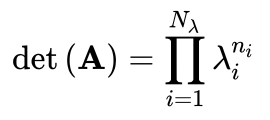
- Methods to calculate eigenvalues and eigenvectors
-
Old-school method:
Solve characteristic equation $A - \lambda \cdot I = 0$ —> $det(A - \lambda \cdot I) = 0$.
Example
\[A = \begin{bmatrix} 2 & 2 \\ 1 & 3 \end{bmatrix}\] \[det(A - \lambda \cdot I) = 0 \\ \Rightarrow (4 - \lambda) \cdot (1 - \lambda) = 0 \\ \Rightarrow \lambda = 1 \space, \space \lambda = 4\]Finally, we have 2 eigenvectors: $\begin{bmatrix} 1\ -1 \end{bmatrix} \space , \space \begin{bmatrix} 1 \ 2 \end{bmatrix}$.
-
Others
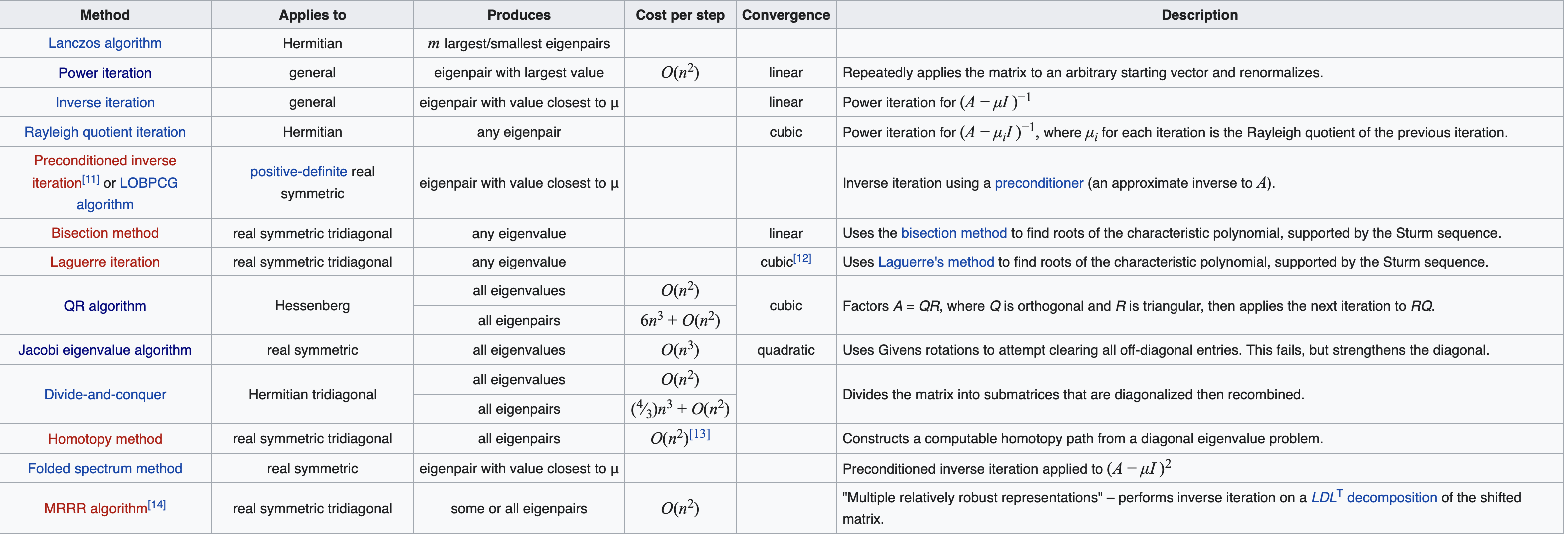
-
Source: Wikipedia.
-
Experiment on longterm behaviors and power iteration method (Include code).
- A cool things in finding eigenvalues.
- Consider a model with a linear transformation of $v_{output}= A^n \cdot v_{input}$ (Applying multiplication of A into vector V, of n times).
- We initialize model with a random 5x5 matrix A whose elements follow a Gaussian distribution, mean = 0, variance = 1.
ximport numpy as np import matplotlib.pyplot as plt #initialize matrix A np.random.seed(8675309) A = np.random.randn(5, 5)
#initialize vector v v_in = np.random.randn(5, 1) norm_of_v = [np.linalg.norm(v_in)]#Implement n = 100 n = 100 for i in range(1, n): v_in = A.dot(v_in) norm_of_v.append(np.linalg.norm(v_in)) plt.plot(norm_list) plt.xlabel("Iteration") plt.ylabel("Value") plt.show()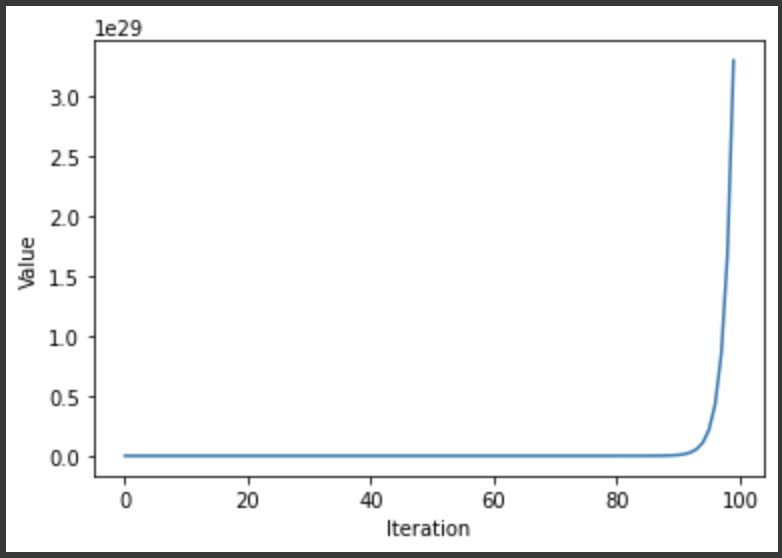
—> The norms just increase significantly.
—> Because we apply A n times in the vector V, therefore, the norm of the vectors keep stretching enormously.
If we take a list of quotient, a pattern will show up.
quotients = [] for i in range(1, 100): quotients.append(norm_of_v[i] / norm_of_v[i - 1]) print("Approxiamtion for eigenvalue is", quotients[-1]) plt.plot(quotients) plt.xlabel("Iteration") plt.ylabel("Value") plt.show()

—> The ratio ocillate in a stable value (about 1.98), which is also the largest eigenvalue, called “singular value”. —> this is so called “rate of convergence”
If we use the numpy library to compute the eigenvalues (cross check):
eigs_vals = np.linalg.eigvals(A).tolist() eigs_vals
—> This results contain many complex numbers. This can be thought of stretching or rotating.
—> Taking the Euclidean norm of all the values (both real and complex number) —> we obtain the stretching factors (eigenvalues) with numpy.
norm_eigs = [np.absolute(x) for x in eigs_vals] norm_eigs.sort() #sorting to be more easy to visualize print(f'norms of eigenvalues: {norm_eigs}')
The biggest value is 1.9744593214850743 —> this is so important that we can call it “principle eigenvalue”, which is so close to our approximation (1.9744593214851518).
-
Power Iteration method
a. Dominant Eigenvalues (Singular Value)
Definition: Let $\lambda_1, \lambda_2, \lambda_3, …. \lambda_n$ be the eigenvalues of N x N matrix A. $\lambda_1$ is called the dominant eigenvectors of A if:
\[|\lambda_1| > |\lambda_i|, i= 2, 3,... n\]b. Approach to power method.
- As witness from the implementation above, we can obtain how to use this iterative method on finding eigenvalues.
-
Simply, we will apply dot product of an original matrix A to a vector V and continue apply A to the result A.v:
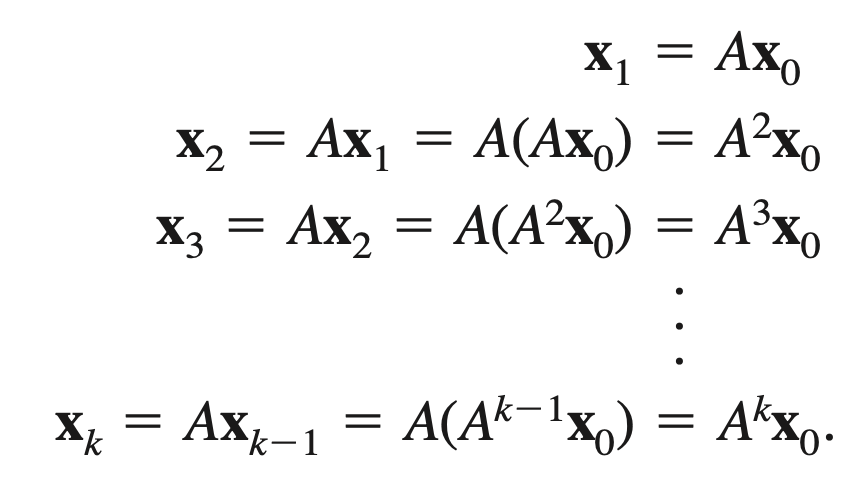
- For the large number of k —> we can obtain good approximation.
- Example: We have matrix A and vector x.
-
Then we can obtain:
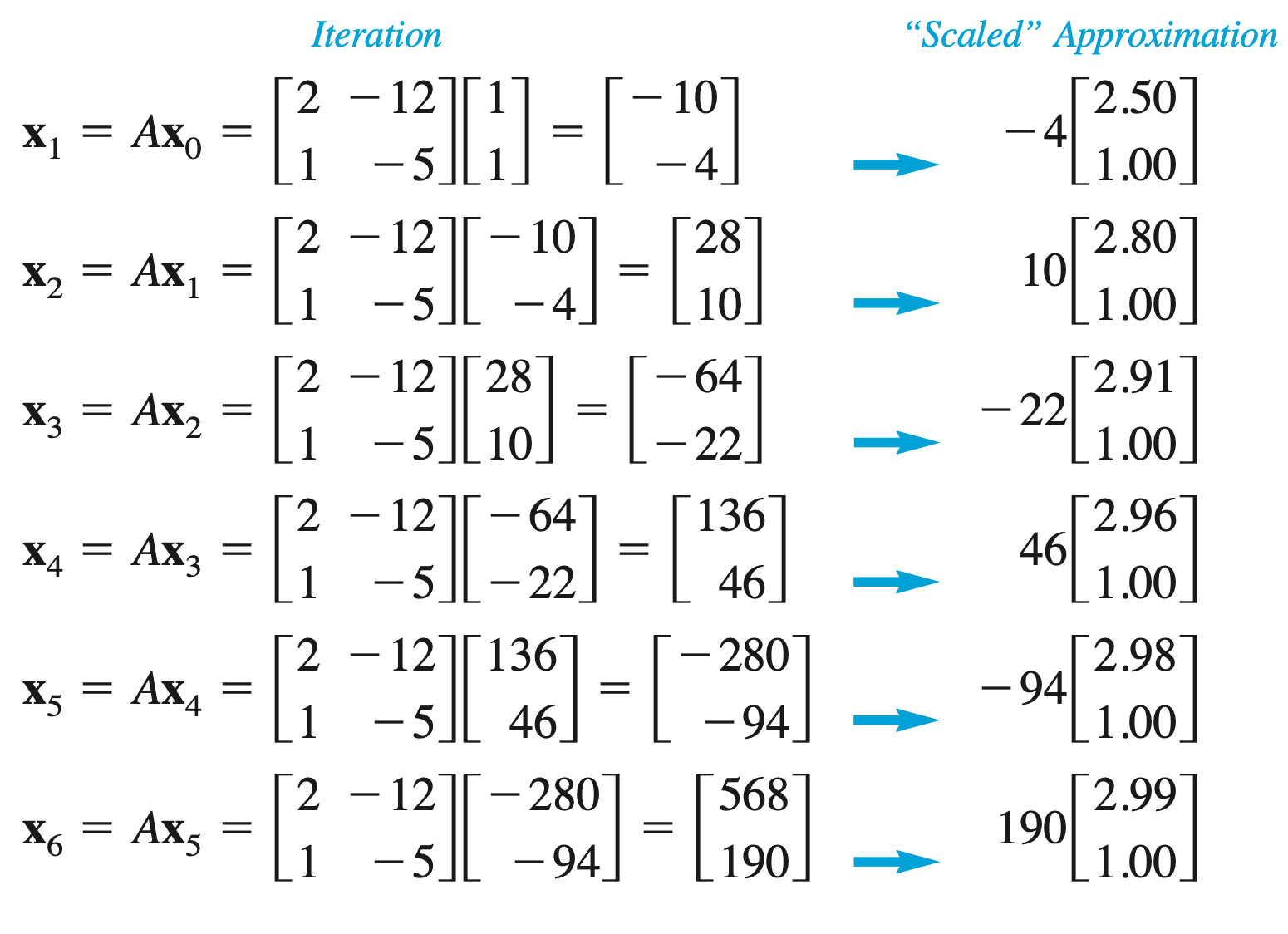
c. Rayleigh quotient to get the eigenvalue
Definition: If x is an eigenvector of a matrix A, then its corresponding eigenvalue is given by
\[\lambda = \frac{A\cdot x}{x\cdot x}\]Proof:
We have: $A\cdot x = \lambda \cdot x$
We can write:
\[\frac{A\cdot x \cdot x}{x \cdot x} = \frac{\lambda \cdot x\cdot x}{x\cdot x} = \lambda\]For the above example: we have


So, A.x. x = -20.0 and x. x = 9.94 —> $\lambda = \frac{A\cdot x \cdot x}{x \cdot x} = \frac{-20.0}{9.94} = -2.01$
d. Rate of Convergence of Power Method
We have matrix \(A = \begin{bmatrix} 4 & 5 \\ 6 & 5 \end{bmatrix}\) has eigenvalues \(\lambda_1 = 10, \lambda_2 = -1\)
—> The ratio is \(\frac{\lambda_2}{\lambda_1} = 0.1\)
e. Complexity: O(n^2)
